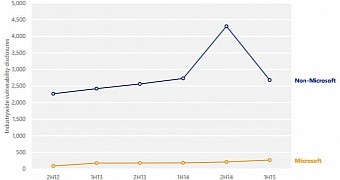Microsoft has recently published the Security Intelligence Report volume 19 to provide a closer look at the latest security trends affecting both its software and that developed by other companies.
The software giant reveals that the number of vulnerability disclosures for Microsoft products increased from 209 in the second half of 2014 to 266 in the first half of 2015, which is a growth of 27.3 percent.
While this looks like a lot, the company shows in the graph you can also see here that the number of vulnerability disclosures for non-Microsoft products is much higher, although a significant drop was recorded from H2 2014 to H1 2015 (notice that the graph shows the overall figures for all non-Microsoft products).
Third-party apps still the most vulnerable
Microsoft also shows that, for the moment, web browsers, the core operating system and OS apps account for the smallest part of vulnerability disclosures, while other applications are responsible for nearly 55.6 percent of all reports.
Microsoft explains in the official documents:
“Disclosures of vulnerabilities in applications other than web browsers and operating system applications decreased by nearly half from 2H14 to 1H15, but remained the most common type of vulnerability in 1H15, accounting for 55.6 percent of all disclosures for the period. A research project in 2H14 uncovered SSL vulnerabilities in a large number of Android apps in the Google Play Store, explaining the increase and subsequent decrease of application vulnerabilities.”
Microsoft has significantly improved the security of Windows in the latest few years, and the company guarantees that, with Windows 10, users and their data are significantly more secure.
Windows 10 and the pre-installed apps employ new security systems to block exploits and make it harder for an intruder to access user data. Edge browser, for instance, no longer allows the installation of third-party add-ons unless they're approved by Microsoft and the user, thus making it impossible for malicious toolbars to reach your PC.

 14 DAY TRIAL //
14 DAY TRIAL //